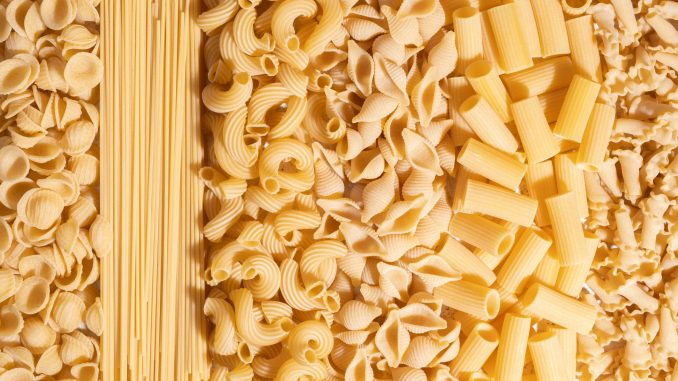
The methods describing how pasta and noodles are analysed are many and varied. It’s worth just reviewing some of the techniques here that developers need when defining texture, colour and taste.
Colour
Pasta colour is usually measured using a colourimeter and developing a Hunter-LAB profile. Pasta colour is calibrated against a white background plate of defined LAB values. To obtain an accurate measure, pasta is dried at say 65ºC for 5 hours after preparation. Samples are cooked at the optimum cooking temperature and time in boiling water and the colour measured of both a dried and cooked portion.
Pasta has a tendency to brown through a combination of Maillard browning – both enzymic and non-enzymic browning other various times.
The introduction of other ingredients can have a profound effect on browning.
Cooking Properties of Pasta
Optimum Cooking Time
Method AACC 16-50 2000 is used here. Raw pasta is cooked in a defined amount of boiling water. Samples are removed every half-minute and samples squeezed between two glass plates. The time for the inner white core of the pasta to disappear is determined as the optimum cooking time.
Cooking Loss
Cooking loss is monitored using a method of Tudorica et al., (2002). Pasta samples (10g) are cooked at the optimum cooking time (OCT) in a defined amount of boiling water and the cooking water collected in an aluminium vessel. This is air dried in an air over at 105ºC until a constant weight was reached. The weight of the dried residue is expressed as a percentage of the starting material.
Water Absorption and Swelling Index
Pasta sample (10 g, 40 mm long) was cooked at OCT and the cooked strands were dried at 105 °C until a constant weight was reached (Tudorica et al., 2002). The swelling index and water absorption were calculated as follows:
swelling index = (weight of cooked pasta – weight of cooked pasta after drying) / weight of cooked pasta after drying
Water absorption = (weight of cooked pasta – weight of raw pasta after drying) / weight of raw pasta
High-quality pasta should roughly double in size during cooking as it absorbs water (Kruger et al., 1996).
Texture Profiling
Samples are analysed using a texture analyser such as those manufactured by SMS (Stable Micro System, Surrey, UK) or Instron (Krishnan et al., 2012).
Sensory Analysis
A panel, usually over 12 strong will assess color, flavor, hardness, and overall acceptability of pasta. A rating scale is needed – a 9-point hedonic rating scale is useful. Alternative approaches might be using a Mixed Structured Scale [MSS]. Further work using Quantitative Descriptive Analysis (QDA) is feasible. A typical group of attributes would be appearance, color, odor, hardness, elasticity, stickiness, grittiness, taste, residual bitterness and overall quality.
Pasta Microstructure
Use a scanning electron microscope. Cooked pasta was rapidly freeze-dried, stuck on a specimen holder with scotch tape on both sides, and then sputter-coated with gold particles. Each pasta sample was observed at an accelerating voltage of 5 kV. The SEM images were scanned at 1000 × magnification.
Trypsin Inhibitor Activity
The trypsin inhibitor activity ( TIA) of raw legume flours and spaghetti samples before cooking and after cooking is determined using BAPNA (Nα-benzoyl-DL-arginine-p-nitroanilide) as the substrate for trypsin, using the procedure of Kakade et al. (1974).The ground samples are extracted with 0.01 N NaOH. The absorbance of the filtrate after reaction with BAPNA is measured at 410nm. One trypsin inhibitor unit (TIU) is arbitrarily defined as a decrease of 0.01 absorbance units at 410 nm.
References
, , . (2002). Nutritional and physicochemical characteristics of dietary fiber enriched pasta. J Agric Food Chem. 50 pp. 347–56


Leave a Reply